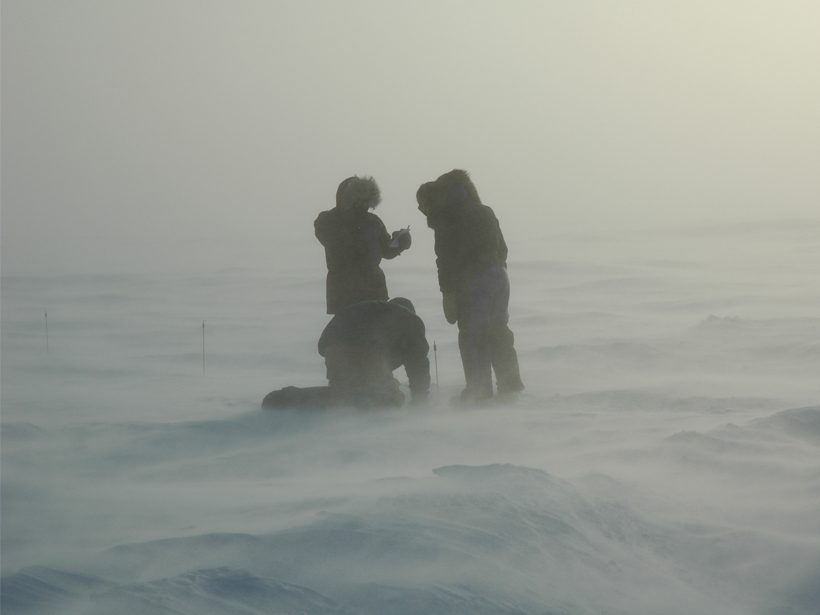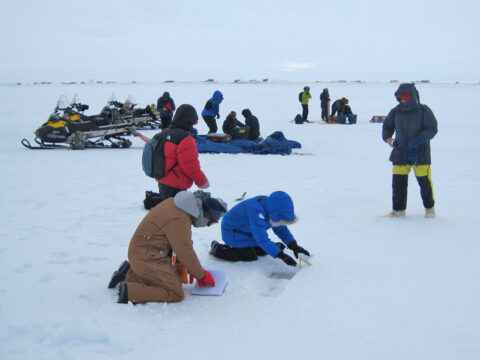It takes a community to describe a snow cover. That was the premise of a 3-day Snow on Sea Ice Workshop in late April and early May in Barrow, Alaska. The goal was to improve the treatment of snow on sea ice in climate models. For much of the year, snow covers Arctic and Antarctic sea ice. The characteristics of this snow cover vary from place to place and over time. This snow cover affects the surface heat budget, the heat exchanged between the ocean and atmosphere, ice growth, ice melt, and light transmission to the ocean. It is essential, therefore, that the extent and properties of the snow cover are accurately represented in climate models.
Workshop organizers used a novel approach by bringing together six researchers whose work is based primarily on field observations with eight scientists whose research is based largely on sea ice and climate models. The workshop included both classroom and field components. The group discussed the properties of snow cover on sea ice and how best to represent these characteristics in models. The field observers were able to learn which snow properties are of greatest concern in climate models, and modelers had an opportunity to see and sample snow on sea ice.
The group identified important modeling issues for snow on sea ice in the classroom and then explored these issues on the ice. Classroom discussions, for example, highlighted how models often treat the snow cover as a single layer with uniform properties. The scientists tested this assumption on site by digging snow pits to measure vertical profiles of snow temperature, density, grain size, and shape and by conducting surveys of snow depths. Participants took measurements at two sites, one with rough first-year ice and the second with smooth first-year ice.
The observed stratigraphy indicated a two-layer snow cover consisting of a thick wind slab and a thin base layer of depth hoar. The wind slab consisted of rounded grains, which simplifies calculations of light reflection, absorption, and transmission in the snow. However, snow depth was far from uniform, with median values of 0.1 m for smooth ice and 0.3 m for rough ice. Depths ranged from 0.02 to 1.20 m.
The key outcome was the collaborative interaction and discussion between modelers and observers.
The particulars of the observations, although significant, were not the most important result of the workshop. The key outcome was the collaborative interaction and discussion between modelers and observers. To focus future efforts, the group determined a few central modeling concerns regarding snow on sea ice. These include the need for model parameterizations to represent factors driving the spatial heterogeneity of snow and implementing within the model the processes that drive snow metamorphism, which affects snow thermal and radiative properties.
During the workshop, observers learned which snow measurements are the most important from a modeling perspective. Modelers made observations in the field and experienced both the simplicity and complexity of snow on sea ice. This workshop resulted in a better-informed and more coordinated research community, which will help advance the development of improved snow-on-sea-ice treatments within climate models.
The workshop was sponsored by the Office of Naval Research and the National Science Foundation. Information on the meeting can be found on the Snow on Sea Ice Workshop website.
—Don Perovich, Thayer School of Engineering, Dartmouth College, Hanover, N.H.; email: [email protected]; Marika Holland, National Center for Atmospheric Research, Boulder, Colo.; and Elizabeth Hunke, Los Alamos National Laboratory, Los Alamos, N.M.
Citation: Perovich, D., M. Holland, and E. Hunke (2015), Improving representation of snow on sea ice in climate models, Eos, 96, doi:10.1029/2015EO039419. Published on 16 November 2015.
Text © 2015. The authors. CC BY-NC 3.0
Except where otherwise noted, images are subject to copyright. Any reuse without express permission from the copyright owner is prohibited.


